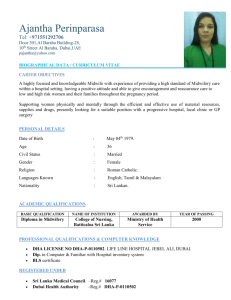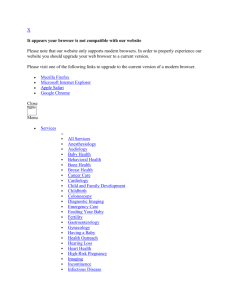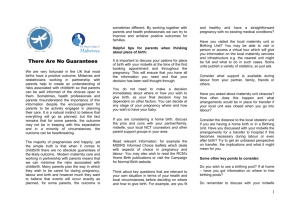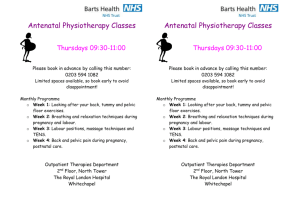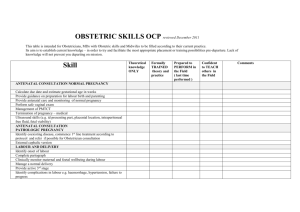Normal Birth - Best Start Resource Centre
advertisement
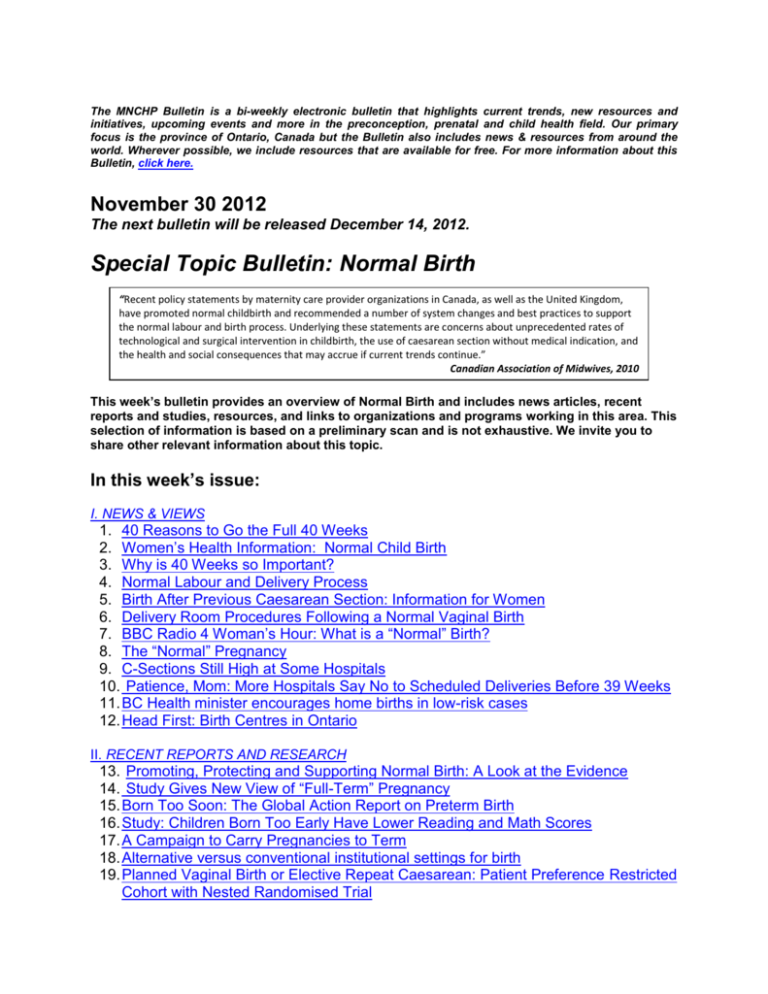
The MNCHP Bulletin is a bi-weekly electronic bulletin that highlights current trends, new resources and initiatives, upcoming events and more in the preconception, prenatal and child health field. Our primary focus is the province of Ontario, Canada but the Bulletin also includes news & resources from around the world. Wherever possible, we include resources that are available for free. For more information about this Bulletin, click here. November 30 2012 The next bulletin will be released December 14, 2012. Special Topic Bulletin: Normal Birth “Recent policy statements by maternity care provider organizations in Canada, as well as the United Kingdom, have promoted normal childbirth and recommended a number of system changes and best practices to support the normal labour and birth process. Underlying these statements are concerns about unprecedented rates of technological and surgical intervention in childbirth, the use of caesarean section without medical indication, and the health and social consequences that may accrue if current trends continue.” Canadian Association of Midwives, 2010 This week’s bulletin provides an overview of Normal Birth and includes news articles, recent reports and studies, resources, and links to organizations and programs working in this area. This selection of information is based on a preliminary scan and is not exhaustive. We invite you to share other relevant information about this topic. In this week’s issue: I. NEWS & VIEWS 1. 40 Reasons to Go the Full 40 Weeks 2. Women’s Health Information: Normal Child Birth 3. Why is 40 Weeks so Important? 4. Normal Labour and Delivery Process 5. Birth After Previous Caesarean Section: Information for Women 6. Delivery Room Procedures Following a Normal Vaginal Birth 7. BBC Radio 4 Woman’s Hour: What is a “Normal” Birth? 8. The “Normal” Pregnancy 9. C-Sections Still High at Some Hospitals 10. Patience, Mom: More Hospitals Say No to Scheduled Deliveries Before 39 Weeks 11. BC Health minister encourages home births in low-risk cases 12. Head First: Birth Centres in Ontario II. RECENT REPORTS AND RESEARCH 13. Promoting, Protecting and Supporting Normal Birth: A Look at the Evidence 14. Study Gives New View of “Full-Term” Pregnancy 15. Born Too Soon: The Global Action Report on Preterm Birth 16. Study: Children Born Too Early Have Lower Reading and Math Scores 17. A Campaign to Carry Pregnancies to Term 18. Alternative versus conventional institutional settings for birth 19. Planned Vaginal Birth or Elective Repeat Caesarean: Patient Preference Restricted Cohort with Nested Randomised Trial III. PROFESSIONAL STATEMENTS ON NORMAL CHILDBIRTH 20. Joint Statement on Normal Childbirth 21. Supporting Healthy an Normal Physiologic Childbirth: A Consensus Statement by ACNM, MANA and NACPM 22. Midwifery Care and Normal Birth IV. CURRENT INITIATIVES 23. March of Dimes Prematurity Campaign 24. B.C. Power to Push V. RESOURCES 25. Care in Normal Birth: A Practical Guide 26. Queensland Maternity and Neonatal Clinical Guideline: Normal Birth 27. Campaign for Normal Birth: Getting Off the Bed 28. E-Learning Normal Pregnancy VI. FEATURED BEST START RESOURCES 29. Giving Birth in a New Land – A guide for women new to Canada and their families I. NEWS & VIEWS 1. 40 Reasons to Go the Full 40 Weeks This website (health4moms.org, 2012) provides readers with 40 reasons to continue their pregnancy to 40 weeks. Reasons include: fewer complications during birth, increased fetal brain and muscle development, easier breastfeeding, a shorter hospital stay and a decrease in the baby’s risk for jaundice, low blood sugar and infection. http://www.health4mom.org/a/40_reasons_121611 2. Women’s Health Information: Normal Child Birth This website (Society of Obstetricians and Gynaecologists of Canada, 2011), provides information on what constitutes a normal childbirth. A normal childbirth is defined as childbirth in which the mother goes into spontaneous labour between the 37th and 42nd week of pregnancy and the baby is born headfirst through the vagina. If the baby’s feet or buttocks enter the birth canal first, a normal birth still might be possible but will require special care. Interventions that are considered part of normal childbirth include the augmentation of labour, fetal heartbeat monitoring, artificial rupture of the membrane (breaking a woman’s water), medications to reduce labour pain (such as epidurals, injectable painkillers and nitrous oxide), and the administration of oxytocin (a medication that will help the uterus to shrink and prevent blood loss). The use of forceps or a vacuum to assist with labour is not considered Page |2 to be part of normal childbirth. A caesarean section is also not considered to be part of normal childbirth. http://www.sogc.org/health/pregnancy-normal_e.asp 3. Why is 40 Weeks So Important? There are many factors that lead to preterm birth. These include: being pregnant with multiple babies (e.g. twins or triplets), uterine or cervical abnormalities (such as fibroid tumours in the uterus), diabetes, high blood pressure, blood clotting disorders, problems with the placenta or bleeding, being overweight, being underweight, a short duration between pregnancies, previous preterm birth, stress, smoking, drinking, drug use, and late or no prenatal care. Preterm babies may experience trouble breathing and keeping warm. They may also experience feeding problems, newborn jaundice, a longer hospital stay and a less developed brain. As children, they are more likely to be diagnosed with Attention Deficit Hyperactivity Disorder (ADHD). As adults, they may be more likely to be diagnosed with diabetes, high blood pressure or heart disease (New York State Department of Health, 2009). http://www.health.ny.gov/community/pregnancy/why_is_40_weeks_so_important.htm 4. Normal Labour and Delivery Process This guide outlines what typically happens during the 3 stages of labour and post delivery during a normal birth (WedMD, 2012). Topics include signs of labour, dilation of the cervix, and pain management. http://www.webmd.com/baby/guide/normal-labor-and-delivery-process 5. Birth After Previous Caesarean Section: Information for Women Women who have previously had a caesarean section are less likely to be able to have a normal vaginal birth (compared to those who have had a previous vaginal birth). Having a vaginal birth after caesarean section has several benefits including: greater safety, increased self-esteem among mothers, easier breastfeeding, a shorter recovery time and lower risk of complications. For women who have previously had a caesarean section, there is a small risk of their caesarean scar opening during labour (approximately 1 in 400) and a small risk (approximately 1 in 3000) of bleeding necessitating hysterectomy. This guide also outlines techniques for increasing the chances of having a normal birth, (e.g. moving around), as well as pain relief options. The advantages and disadvantages of having a caesarean are also outlined in this document (Kings College Hospital, nd). http://www.kch.nhs.uk/Doc/PL%20-%20221.1%20%20Vaginal%20Birth%20After%20Caesarean%20Section.pdf 6. Delivery Room Procedures Following a Normal Vaginal Birth This article (Healthychildren.org, 2012), describes the post-delivery period following a normal vaginal birth. Following a normal vaginal birth, the umbilical chord will be clamped and cut. The baby will be dried, examined, weighed and measured. Vitamin K and antiseptic eye-drops or ointment will also be given to the baby (as Vitamin K levels are low in newborns and the bacteria found in the birth canal can Page |3 infect a baby’s eyes). Women should attempt breastfeeding soon after delivery and should maximize skin-to-skin contact with their babies. http://www.healthychildren.org/English/ages-stages/prenatal/delivery-beyond/Pages/default.aspx 7. BBC Radio 4 Woman’s Hour: What is a “Normal” Birth? In this 11-minute radio program (BBC, 2012), Cathy Warwick of the Royal College of Midwives and Pauline Hull of electivecesarean.com discuss issues surrounding normal births and current services and guidelines. http://www.bbc.co.uk/programmes/p00y43jx 8. The “Normal” Pregnancy This guide (Babyzone, 2012), outlines for mothers common experiences during the 3 trimesters of normal pregnancy. http://www.babyzone.com/pregnancy/your-body-during-pregnancy/normal-pregnancy_70514 9. C-Sections Still High at Some Hospitals This article (Toronto Star, 2012) highlights the fact that the C-section rate in many Canadian hospitals exceeds the World Health Organization’s recommended C-section rate of between 5 and 15 percent. The Canadian Institute for Health Information (CIHI) has found that there are C-section rates of between 30 and 40 percent in several Canadian hospitals. These numbers may be high due to Canadian women having babies at an older age. As older women are often more educated, they may be less willing to take risks if there are signs of trouble during labour. These numbers may also reflect physicians’ fear of legal suits. http://www.thestar.com/news/gta/article/1156778--c-section-still-high-at-some-hospitals 10. Patience, Mom: More Hospitals Say No to Scheduled Deliveries Before 39 Weeks As new research emerges that highlights the large amount of critical development that babies do during their final weeks in utero, hospitals in the United States are increasingly disallowing elective inductions and C-sections prior to 39 weeks gestation (Time Magazine, 2011). http://healthland.time.com/2011/08/26/patience-please-39-weeks-is-the-new-thinking-about-when-todeliver-babies/ 11. BC Health minister encourages home births in low-risk cases When B.C. Health Minister Margaret MacDiarmid trained as a physician in the 1980s, home births were not even contemplated as a safe alternative. MacDiarmid, the former president of the B.C. Medical Association, is encouraging women with low-risk pregnancies to plan their deliveries at home if that's what they'd like, citing B.C. research published in the Canadian Medical Association Journal in 2009 as the safety standard. Page |4 As long as mothers were screened to be low-risk and assisted by a registered midwife, "there wasn't any difference between the outcomes for moms and babies whether they were at home or in a hospital," she said, adding it would also save the health system money. http://www.timescolonist.com/Health+minister+encourages+home+births+risk+cases/7481232/story.ht ml#ixzz2Dj864sdW 12. Head First: Birth Centres in Ontario Ontario recently announced funding for two birth centres that will be led by midwives. The government has indicated it is opening birth centres partly to move care out of hospitals and save money. Although birth centres are probably safe and may improve maternity care, it is less clear whether Ontario’s birth centres will indeed reduce costs. http://healthydebate.ca/2012/04/topic/innovation/the-evidence-for-birthing-centers-in-ontario II. RECENT REPORTS AND RESEARCH 13. Promoting, Protecting, and Supporting Normal Birth: A Look at the Evidence Romano A and Lothiano J. Interfering with the normal physiological process of labor and birth in the absence of medical necessity increases the risk of complications for mother and baby. Six evidence-based care practices promote physiological birth: avoiding medically unnecessary induction of labor, allowing freedom of movement for the laboring woman, providing continuous labor support, avoiding routine interventions and restrictions, encouraging spontaneous pushing in nonsupine positions, and keeping mothers and babies together after birth without restrictions on breastfeeding. Nurses are in a unique position to provide these care practices and to help childbearing women make informed choices based on evidence http://onlinelibrary.wiley.com/doi/10.1111/j.1552-6909.2007.00210.x/full 14. Study Gives New View of ‘Full-Term’ Pregnancy A study conducted by Dr. Uma Reddy has found that babies born during weeks 39, 40 or 41 of pregnancy, have lower rates of infant mortality than those born during weeks 37 or 38. The risk for newborn death remains small, but doubles for those born before 37 weeks (which is considered a full term) (WebMD, 2011). http://www.webmd.com/baby/news/20110523/study-gives-new-view-of-full-term-pregnancy 15. Born Too Soon: The Global Action Report on Preterm Birth This guide on preterm birth provides readers information on why a normal birth is desirable. It also includes a discussion of preterm birth around the globe, care before and between pregnancy (to Page |5 promote normal birth), and care during pregnancy and childbirth. http://www.marchofdimes.com/downloads/BornToSoonGARonPretermBirth_05212012.pdf 16. Study: Children Born Too Early Have Lower Reading and Math Scores Children who were delivered after 39 weeks of pregnancy have been found to score higher on standardized third grade reading and math tests, (even compared to those who were born at 37 and 38 weeks). Compared with children born at 41 weeks, those born at 37 weeks had a 14% greater risk of having a mild reading impairment and a 33% higher chance of having a severe reading impairment. Children born at 37 weeks had a 16% greater risk of having a mild impairment in performing basic math skills (compared with those born at 41 weeks). For each additional week of gestation, scores were found to improve. This may be due to the fact that even though pregnancy at 37 weeks is considered full term, babies do a lot of critical development in the last weeks of pregnancy (Time Magazine, 2012). http://healthland.time.com/2012/07/02/study-children-born-too-early-have-lower-reading-and-mathscores/ http://pediatrics.aappublications.org/content/early/2012/06/27/peds.2011-2157 17. A Campaign to Carry Pregnancies to Term It has been found that well-educated women may be more inclined to schedule childbirth for a time that is more convenient for themselves and their family members. Physicians may also be inclined to schedule births during times that better suit their schedules. However, it has been found that babies are not fully developed until at lest 39 weeks of gestation. There are fewer vision and hearing problems among babies born at full term. These babies are also less likely to experience respiratory distress, jaundice and low blood pressure (New York Times, 2011). http://www.nytimes.com/2011/08/09/health/09brody.html?_r=0 18. Alternative versus conventional institutional settings for birth Ellen D Hodnett, Soo Downe, Denis Walsh3, Julie Weston Background Home-like birth settings have been established in or near conventional labour wards for the care of pregnant women who prefer and require little or no medical intervention during labour and birth. Objectives Primary: to assess the effects of care in a home-like birth environment compared to care in a conventional labour ward. Secondary: to determine if the effects of birth settings are influenced by staffing or organizational models or geographical location of the birth centre. Search strategy We searched the Cochrane Pregnancy and Childbirth Group trials register (18 May 2004) and handsearched eight journals and two published conference proceedings. Selection criteria All randomized or quasi-randomized controlled trials that compared the effects of a home-like institutional birth environment to conventional hospital care. Page |6 Data collection and analysis Standard methods of the Cochrane Collaboration Pregnancy and Childbirth Group were used. Two review authors evaluated methodological quality. Double data entry was performed. Results are presented using relative risks and 95% confidence intervals. Main results Six trials involving 8677 women were included. No trials of freestanding birth centres were found. Between 29% and 67% of women allocated to home-like settings were transferred to standard care before or during labour. Allocation to a home-like setting significantly increased the likelihood of: no intrapartum analgesia/anaesthesia (four trials; n = 6703; relative risk (RR) 1.19, 95%confidence interval (CI) 1.01 to 1.40), spontaneous vaginal birth (five trials; n = 8529; RR 1.03, 95% CI 1.01 to 1.06), vaginal/perineal tears (four trials; n = 8415; RR 1.08, 95% CI 1.03 to 1.13), preference for the same setting the next time (one trial; n = 1230; RR 1.81, 95% CI 1.65 to 1.98), satisfaction with intrapartum care (one trial; n = 2844; RR 1.14, 95% CI 1.07 to 1.21), and breastfeeding initiation (two trials; n = 1431; RR 1.05, 95% CI 1.02 to 1.09) and continuation to six to eight weeks (two trials; n = 1431; RR 1.06, 95% CI 1.02 to 1.10). Allocation to a home-like setting decreased the likelihood of episiotomy (five trials; n = 8529; RR 0.85, 95% CI 0.74 to 0.99). There was a trend towards higher perinatal mortality in the homelike setting (five trials; n = 8529; RR 1.83, 95% CI 0.99 to 3.38). No firm conclusions could be drawn regarding the effects of staffing or organizational models. Authors’ conclusions When compared to conventional institutional settings, home-like settings for childbirth are associated with modest benefits, including reduced medical interventions and increased maternal satisfaction. Caregivers and clients should be vigilant for signs of complications. Alternative versus conventional institutional settings for birth. CochraneDatabase of Systematic Reviews 2010, Issue 9. Art. No.: CD000012. DOI: 10.1002/14651858.CD000012.pub3. www.thecochranelibrary.com/details/file/841529/CD000012.html 19. Planned Vaginal Birth or Elective Repeat Caesarean: Patient Preference Restricted Cohort with Nested Randomised Trial Caroline A. Crowther et al. Background Uncertainty exists about benefits and harms of a planned vaginal birth after caesarean (VBAC) compared with elective repeat caesarean (ERC). We conducted a prospective restricted cohort study consisting of a patient preference cohort study, and a small nested randomised trial to compare benefits and risks of a planned ERC with planned VBAC. Methods and findings 2,345 women with one prior caesarean, eligible for VBAC at term, were recruited from 14 Australian maternity hospitals. Women were assigned by patient preference (n = 2,323) or randomisation (n = 22) to planned VBAC (1,225 patient preference, 12 randomised) or planned ERC (1,098 patient preference, ten randomised). The primary outcome was risk of fetal death or death of liveborn infant before discharge or serious infant outcome. Data were analysed for the 2,345 women (100%) and infants enrolled. Page |7 The risk of fetal death or liveborn infant death prior to discharge or serious infant outcome was significantly lower for infants born in the planned ERC group compared with infants in the planned VBAC group (0.9% versus 2.4%; relative risk [RR] 0.39; 95% CI 0.19–0.80; number needed to treat to benefit 66; 95% CI 40–200). Fewer women in the planned ERC group compared with women in the planned VBAC had a major haemorrhage (blood loss ≥1,500 ml and/or blood transfusion), (0.8% [9/1,108] versus 2.3% [29/1,237]; RR 0.37; 95% CI 0.17–0.80). Conclusions Among women with one prior caesarean, planned ERC compared with planned VBAC was associated with a lower risk of fetal and infant death or serious infant outcome. The risk of major maternal haemorrhage was reduced with no increase in maternal or perinatal complications to time of hospital discharge. Women, clinicians, and policy makers can use this information to develop health advice and make decisions about care for women who have had a previous caesarean. http://www.plosmedicine.org/article/info%3Adoi%2F10.1371%2Fjournal.pmed.1001192 III. PROFESSIONAL STATEMENTS ON NORMAL CHILDBIRTH 20. Joint Statement on Normal Childbirth The Society of Obstetricians and Gynaecologists of Canada, the Association of Women’s Health, the Obstetric and Neonatal Nurses of Canada, the Canadian Association of Midwives, the College of Family Physicians of Canada and the Society of Rural Physicians of Canada (2008), jointly wrote this statement on normal childbirth. A normal birth is defined as the spontaneous onset and progress of labour, resulting in spontaneous delivery at 37 to 42 weeks gestation. Such a delivery may include pharmacological and non-pharmacologic analgesia and routine oxytocic during the third stage of labour. A normal delivery is not assisted by forceps, vacuum or caesarean section. However, it may include induction, augmentation, electronic fetal monitoring, regional anaesthesia and complications of pregnancy, (so long as the delivery is normal (spontaneous)). Normal birth includes the opportunity for skin-to-skin holding and breastfeeding in the first hour after birth. In this document it is recommended that national guidelines for normal birth be created, that childbirth educators and maternity care providers be equipped with knowledge and experience about normal childbirth, and that providers discuss the possibility of normal childbirth with all low-risk patients. http://www.sogc.org/guidelines/documents/gui221PS0812.pdf 21. Supporting Healthy and Normal Physiologic Childbirth: A Consensus Statement by ACNM, MANA and NACPM. This guideline written by the Midwives Alliance of North America (MANA), the American College of Nurse-Midwives (ACMN), and the National Association of Certified Professional Midwives (NACPM) Page |8 (2012), outlines the characteristics of a normal physiologic childbirth, the factors that influence and disrupt a normal physiologic childbirth, and provides recommendations for policy, education and research to promote normal childbirth, http://www.midwife.org/ACNM/files/ccLibraryFiles/Filename/000000002179/Physioloigical%20Birth%2 0Consensus%20Statement-%20FINAL%20May%2018%202012%20FINAL.pdf 22. Midwifery Care and Normal Birth Canadian Association of Midwives. January, 2010 Recent policy statements by maternity care provider organizations in Canada, as well as the United Kingdom, have promoted normal childbirth and recommended a number of system changes and best practices to support the normal labour and birth process. Underlying these statements are concerns about unprecedented rates of technological and surgical intervention in childbirth, the use of caesarean section without medical indication, and the health and social consequences that may accrue if current trends continue. The Canadian Association of Midwives (CAM) welcomes these important collaborative initiatives toward reducing unnecessary intervention and restoring confidence in the physiologic process of childbirth. CAM also welcomes ongoing discussion about the parameters of normal labour and birth, the attitudes and beliefs that influence maternity care practices, and the actions needed to promote, protect and support normal childbirth as a healthy and meaningful event in women’s lives. CAM believes that midwives are making a vital contribution to interdisciplinary efforts to promote normal birth and decrease the anxiety that often surrounds maternity care today. Trust in the normal childbirth process is fundamental to the philosophy and practice of midwifery, the language midwives speak and the care they provide to women. Midwifery education includes the development of specific skills and clinical practices that facilitate normal, undisturbed labour progress and spontaneous delivery through the efforts of the mother, without routine use of drugs and interventions. For midwives, the concept of normality rests on the physiology of labour and the capacity of women to give birth with their own power. http://www.aom.on.ca/Communications/Position_Statements/CAM_Statement_on_Normal_Birth.aspx http://www.canadianmidwives.org/ IV. CURRENT INITIATIVES 23. March of Dimes Prematurity Campaign March of Dimes aims to reduce the number of babies that are born prematurely each year. In response to this problem, the March of Dimes has launched a Prematurity Campaign. Below are links to the campaign’s general website, the World Prematurity Day Facebook page and the World Prematurity Day Volunteer Guide. Page |9 http://www.marchofdimes.com/mission/prematurity_wpd.html https://www.facebook.com/WorldPrematurityDay http://www.marchofdimes.com/downloads/wpdvolunteerguide.pdf 24. B.C. Power to Push Your maternity care provider will monitor you and oversee your care throughout your pregnancy and birth. In British Columbia, women have a number of options available to them regarding who cares for them during pregnancy, as well as where they will give birth to their baby. When your labour begins spontaneously between 37 and 42 weeks of pregnancy, it’s a clear signal that your baby is now ready to be born. It also means that after nine months, your body has prepared itself to begin the process of labour and birth. http://www.powertopush.ca/ V. RESOURCES 25. Care in Normal Birth: A Practical Guide This document, produced by the World Health Organization (1996), presents universal guidelines for the routine care of women during uncomplicated labour and childbirth. Recommendations for routine care are based on a critical review of the literature with respect to the safety and effectiveness of 59 common procedures and practices. This guide is available in English, French, German, Indonesian and Serbo-Croatian. http://www.who.int/maternal_child_adolescent/documents/who_frh_msm_9624/en/ 26. Queensland Maternity and Neonatal Clinical Guideline: Normal Birth This guideline produced by the Queensland Maternity and Neonatal Clinical Guideline Program (2012), provides healthcare providers with in-depth information about the normal birth process. Topics discussed in this guideline include: a definition of normal birth, initial assessment, the provision of women-centred care, service requirements, supportive care, discomfort and pain. This guideline outlines several aspects of care in labour (such as nutrition, routine procedures, pain management, fetal monitoring and place of birth) and classification of practices in normal birth. http://www.health.qld.gov.au/qcg/documents/g_normbirth.pdf 27. Campaign for Normal Birth: Getting off the Bed This guide (Royal College of Midwives, 2011), outlines for women and midwives the positions that women may take during normal labour and birth to increase comfort. Illustrations are provided. http://www.rcmnormalbirth.org.uk/ P a g e | 10 28. E-Learning: Normal Pregnancy This presentation (London Health Sciences Centre, nd), provides information for healthcare providers on the physiology of normal pregnancy. Information is provided about the different bodily systems of both the fetus and pregnant woman. http://www.lhsc.on.ca/Health_Professionals/CCTC/elearning/normalpregnancy_criticalcarenurses.pdf VI. FEATURED BEST START RESOURCES 29. Giving Birth in a New Land – A guide for women new to Canada and their families This booklet contains information for newcomer women who are pregnant and expect to deliver their baby in Ontario. Includes information on local practices related to the prenatal and postnatal period, as well as services and resources available. Available in print and PDF. Download in English, French, Arabic, Filipino, Hindi, Punjabi, Spanish, Simplified Chinese, Tamil, Urdu. http://www.beststart.org/resources/rep_health/index.html About This Bulletin The Best Start Resource Centre thanks you for your interest in, and support of, our work. Best Start permits others to copy, distribute or reference the work for non-commercial purposes on condition that full credit is given. Because our MNCHP bulletins are designed to support local health promotion initiatives, we would appreciate knowing how this resource has supported, or been integrated into, your work (mnchp@healthnexus.ca). Please note that the Best Start Resource Centre does not endorse or recommend any events, resources, or publications mentioned in this bulletin. Other Health Nexus communications: OHPE - The free weekly Ontario Health Promotion E-mail bulletin (OHPE) offers a digest of news, events, jobs, feature articles on health promotion issues, resources, and much more, to those working in health promotion. http://www.ohpe.ca/ Click4HP - An open, facilitated public listserv, Click4HP is an international dialogue on health promotion. Participants exchange views on issues and ideas, provide leads to resources, and ask questions about health promotion. https://listserv.yorku.ca/archives/click4hp.html The Maternal Newborn and Child Health Promotion (MNCHP) Network - A province-wide electronic forum for service providers working to promote preconception, prenatal and child health. http://www.beststart.org/services/MNCHP.html Health Promotion Today / Promotion de la santé aujourd’hui - 0ur bilingual blog keeps you informed of news and topics related to health promotion. http://www.blogs.healthnexussante.ca/ Follow us on Twitter to stay up to date on all things related to health promotion. https://twitter.com/Health_Nexus View our video resources on YouTube and Vimeo (http://www.youtube.com/user/healthnexussante, https://vimeo.com/user9493317) P a g e | 11 We encourage you visit the website of our new 3M Health Leadership Award to find out how you can support community health leadership and honour your own community leader by nominating them for this national award. http://www.healthnexus.ca/leadershipaward NEW ! The Best Start Aboriginal Sharing Circle (BSASC) Network is a distribution list designed for service providers working with Aboriginal Peoples in areas of preconception, prenatal and child health. The network is a forum to share news, ideas, questions and best practices. http://lists.beststart.org/listinfo.cgi/bsasc-beststart.org En français: Le bulletin francophone Le Bloc-Notes est un outil indispensable pour les intervenants professionnels qui aiment être à l'affût des nouveautés dans le domaine de la promotion de la santé. http://www.leblocnotes.ca/ Le Bulletin de santé maternelle et infantile est un bulletin électronique mensuel à l’intention des fournisseurs de services œuvrant dans le domaine de la promotion de la santé maternelle et infantile. http://www.meilleurdepart.org/services/bulletins.html Promotion de la santé aujourd’hui / Health Promotion Today – Notre blogue bilingue sur lequel on partage des nouvelles et réflexions liées à la promotion de la santé. http://www.blogs.healthnexussante.ca/ Suivez-nous sur Twitter pour demeurer au fait de tout ce qui concerne la promotion de la santé. https://twitter.com/Nexus_Sante Visionner nos ressources vidéo sur YouTube et Vimeo (http://www.youtube.com/user/healthnexussante, https://vimeo.com/user9493317) Nous vous encourageons à visiter le site Web de notre nouveau Prix 3M de leadership en santé pour découvrir de quelle façon vous pouvez appuyer le leadership en santé communautaire et honorer un chef de file de votre milieu en présentant sa candidature à ce prix national. http://www.nexussante.ca/prixdeleadership P a g e | 12
